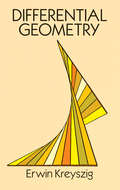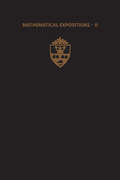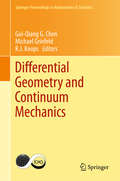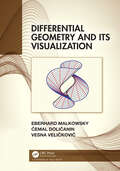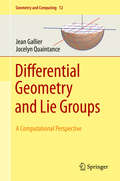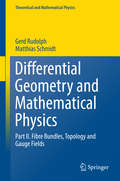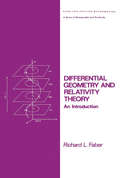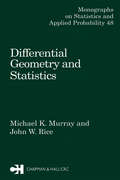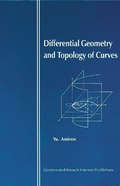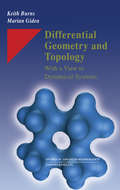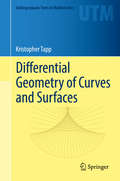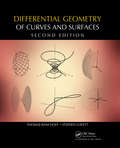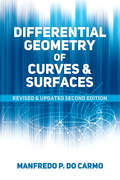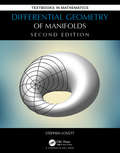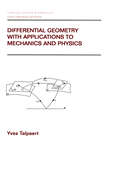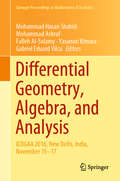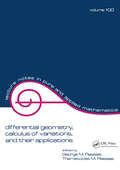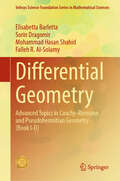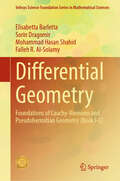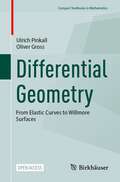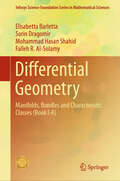- Table View
- List View
Differential Geometry (Dover Books on Mathematics)
by Erwin KreyszigThis outstanding textbook by a distinguished mathematical scholar introduces the differential geometry of curves and surfaces in three-dimensional Euclidean space. The subject is presented in its simplest, most essential form, but with many explanatory details, figures and examples, and in a manner that conveys the geometric significance and theoretical and practical importance of the different concepts, methods and results involved.The first chapters of the book focus on the basic concepts and facts of analytic geometry, the theory of space curves, and the foundations of the theory of surfaces, including problems closely related to the first and second fundamental forms. The treatment of the theory of surfaces makes full use of the tensor calculus.The later chapters address geodesics, mappings of surfaces, special surfaces, and the absolute differential calculus and the displacement of Levi-Cività. Problems at the end of each section (with solutions at the end of the book) will help students meaningfully review the material presented, and familiarize themselves with the manner of reasoning in differential geometry.
Differential Geometry (Mathematical Expositions #no. 11)
by Erwin KreyszigThis book is intended to meet the need for a text introducing advanced students in mathematics, physics, and engineering to the field of differential geometry. It is self-contained, requiring only a knowledge of the calculus. The material is presented in a simple and understandable but rigorous manner, accompanied by many examples which illustrate the ideas, methods, and results. The use of tensors is explained in detail, not omitting little formal tricks which are useful in their applications. Though never formalistic, it provides an introduction to Riemannian geometry.<P><P> The theory of curves and surfaces in three-dimensional Euclidean space is presented in a modern way, and applied to various classes of curves and surfaces which are of practical interest in mathematics and its applications to physical, cartographical, and engineering problems. Considerable space is given to explaining and illustrating basic concepts such as curve, arc length, surface, fundamental forms; covariant and contravariant vectors; covariant, contravariant and mixed tensors, etc.<P> Interesting problems are included and complete solutions are given at the end of the book, together with a list of the more important formulae. No pains have been spared in constructing suitable figures.
Differential Geometry and Continuum Mechanics
by Michael Grinfeld Gui-Qiang G. Chen R. J. KnopsThis book examines the exciting interface between differential geometry and continuum mechanics, now recognised as being of increasing technological significance. Topics discussed include isometric embeddings in differential geometry and the relation with microstructure in nonlinear elasticity, the use of manifolds in the description of microstructure in continuum mechanics, experimental measurement of microstructure, defects, dislocations, surface energies, and nematic liquid crystals. Compensated compactness in partial differential equations is also treated. The volume is intended for specialists and non-specialists in pure and applied geometry, continuum mechanics, theoretical physics, materials and engineering sciences, and partial differential equations. It will also be of interest to postdoctoral scientists and advanced postgraduate research students. These proceedings include revised written versions of the majority of papers presented by leading experts at the ICMS Edinburgh Workshop on Differential Geometry and Continuum Mechanics held in June 2013. All papers have been peer reviewed.
Differential Geometry and General Relativity: Volume 1 (Graduate Texts in Physics)
by Bin Zhou Canbin LiangThis book, the first in a three-volume set, explains general relativity using the mathematical tool of differential geometry. The book consists of ten chapters, the first five of which introduce differential geometry, which is widely applicable even outside the field of relativity. Chapter 6 analyzes special relativity using geometric language. In turn, the last four chapters introduce readers to the fundamentals of general relativity. Intended for beginners, this volume includes numerous exercises and worked-out example in each chapter to facilitate the learning experience. Chiefly written for graduate-level courses, the book’s content will also benefit upper-level undergraduate students, and can be used as a reference guide for practicing theoretical physicists.
Differential Geometry and Its Visualization
by Eberhard Malkowsky Ćemal Dolićanin Vesna VeličkovićDifferential Geometry and Its Visualization is suitable for graduate level courses in differential geometry, serving both students and teachers. It can also be used as a supplementary reference for research in mathematics and the natural and engineering sciences. Differential geometry is the study of geometric objects and their properties using the methods of mathematical analysis. The classical theory of curves and surfaces in three-dimensional Euclidean space is presented in the first three chapters. The abstract and modern topics of tensor algebra, Riemannian spaces and tensor analysis are studied in the last two chapters. A great number of illustrating examples, visualizations and genuine figures created by the authors’ own software are included to support the understanding of the presented concepts and results, and to develop an adequate perception of the shapes of geometric objects, their properties and the relations between them. Features Extensive, full colour visualisations. Numerous exercises. Self-contained and comprehensive treatment of the topic.
Differential Geometry and Lie Groups: A Computational Perspective (Geometry and Computing #12)
by Jean Gallier Jocelyn QuaintanceThis textbook offers an introduction to differential geometry designed for readers interested in modern geometry processing. Working from basic undergraduate prerequisites, the authors develop manifold theory and Lie groups from scratch; fundamental topics in Riemannian geometry follow, culminating in the theory that underpins manifold optimization techniques. Students and professionals working in computer vision, robotics, and machine learning will appreciate this pathway into the mathematical concepts behind many modern applications.Starting with the matrix exponential, the text begins with an introduction to Lie groups and group actions. Manifolds, tangent spaces, and cotangent spaces follow; a chapter on the construction of manifolds from gluing data is particularly relevant to the reconstruction of surfaces from 3D meshes. Vector fields and basic point-set topology bridge into the second part of the book, which focuses on Riemannian geometry.Chapters on Riemannian manifolds encompass Riemannian metrics, geodesics, and curvature. Topics that follow include submersions, curvature on Lie groups, and the Log-Euclidean framework. The final chapter highlights naturally reductive homogeneous manifolds and symmetric spaces, revealing the machinery needed to generalize important optimization techniques to Riemannian manifolds. Exercises are included throughout, along with optional sections that delve into more theoretical topics.Differential Geometry and Lie Groups: A Computational Perspective offers a uniquely accessible perspective on differential geometry for those interested in the theory behind modern computing applications. Equally suited to classroom use or independent study, the text will appeal to students and professionals alike; only a background in calculus and linear algebra is assumed. Readers looking to continue on to more advanced topics will appreciate the authors’ companion volume Differential Geometry and Lie Groups: A Second Course.
Differential Geometry and Lie Groups: A Second Course (Geometry and Computing #13)
by Jean Gallier Jocelyn QuaintanceThis textbook explores advanced topics in differential geometry, chosen for their particular relevance to modern geometry processing. Analytic and algebraic perspectives augment core topics, with the authors taking care to motivate each new concept. Whether working toward theoretical or applied questions, readers will appreciate this accessible exploration of the mathematical concepts behind many modern applications.Beginning with an in-depth study of tensors and differential forms, the authors go on to explore a selection of topics that showcase these tools. An analytic theme unites the early chapters, which cover distributions, integration on manifolds and Lie groups, spherical harmonics, and operators on Riemannian manifolds. An exploration of bundles follows, from definitions to connections and curvature in vector bundles, culminating in a glimpse of Pontrjagin and Chern classes. The final chapter on Clifford algebras and Clifford groups draws the book to an algebraic conclusion, which can be seen as a generalized viewpoint of the quaternions.Differential Geometry and Lie Groups: A Second Course captures the mathematical theory needed for advanced study in differential geometry with a view to furthering geometry processing capabilities. Suited to classroom use or independent study, the text will appeal to students and professionals alike. A first course in differential geometry is assumed; the authors’ companion volume Differential Geometry and Lie Groups: A Computational Perspective provides the ideal preparation.
Differential Geometry and Mathematical Physics
by Matthias Schmidt Gerd RudolphThe book is devoted to the study of the geometrical and topological structure of gauge theories. It consists of the following three building blocks: - Geometry and topology of fibre bundles, - Clifford algebras, spin structures and Dirac operators, - Gauge theory. Written in the style of a mathematical textbook, it combines a comprehensive presentation of the mathematical foundations with a discussion of a variety of advanced topics in gauge theory. The first building block includes a number of specific topics, like invariant connections, universal connections, H-structures and the Postnikov approximation of classifying spaces. Given the great importance of Dirac operators in gauge theory, a complete proof of the Atiyah-Singer Index Theorem is presented. The gauge theory part contains the study of Yang-Mills equations (including the theory of instantons and the classical stability analysis), the discussion of various models with matter fields (including magnetic monopoles, the Seiberg-Witten model and dimensional reduction) and the investigation of the structure of the gauge orbit space. The final chapter is devoted to elements of quantum gauge theory including the discussion of the Gribov problem, anomalies and the implementation of the non-generic gauge orbit strata in the framework of Hamiltonian lattice gauge theory. The book is addressed both to physicists and mathematicians. It is intended to be accessible to students starting from a graduate level.
Differential Geometry and Relativity Theory: An Introduction (Monographs and Textbooks in Pure and Applied Mathematics #76)
by Richard L. Faber<p>Differential Geometry and Relativity Theory: An Introduction approaches relativity asa geometric theory of space and time in which gravity is a manifestation of space-time curvature, rather than a force. Uniting differential geometry and both special and general relativity in a single source, this easy-to-understand text opens the general theory of relativity to mathematics majors having a background only in multivariable calculus and linear algebra. The book offers a broad overview of the physical foundations and mathematical details of relativity, and presents concrete physical interpretations of numerous abstract concepts in Riemannian geometry. <p>The work is profusely illustrated with diagrams aiding in the understanding of proofs and explanations. Appendices feature important material on vector analysis and hyperbolic functions. <p>Differential Geometry and Relativity Theory: An Introduction serves as the ideal text for high-level undergraduate courses in mathematics and physics, and includes a solutions manual augmenting classroom study. It is an invaluable reference for mathematicians interested in differential and Riemannian geometry, or the special and general theories of relativity.</p>
Differential Geometry and Statistics (ISSN)
by M.K. MurraySeveral years ago our statistical friends and relations introduced us to the work of Amari and Barndorff-Nielsen on applications of differential geometry to statistics. This book has arisen because we believe that there is a deep relationship between statistics and differential geometry and moreoever that this relationship uses parts of differential geometry, particularly its 'higher-order' aspects not readily accessible to a statistical audience from the existing literature. It is, in part, a long reply to the frequent requests we have had for references on differential geometry! While we have not gone beyond the path-breaking work of Amari and Barndorff- Nielsen in the realm of applications, our book gives some new explanations of their ideas from a first principles point of view as far as geometry is concerned. In particular it seeks to explain why geometry should enter into parametric statistics, and how the theory of asymptotic expansions involves a form of higher-order differential geometry. The first chapter of the book explores exponential families as flat geometries. Indeed the whole notion of using log-likelihoods amounts to exploiting a particular form of flat space known as an affine geometry, in which straight lines and planes make sense, but lengths and angles are absent. We use these geometric ideas to introduce the notion of the second fundamental form of a family whose vanishing characterises precisely the exponential families.
Differential Geometry and Topology of Curves
by Yu AnimovDifferential geometry is an actively developing area of modern mathematics. This volume presents a classical approach to the general topics of the geometry of curves, including the theory of curves in n-dimensional Euclidean space. The author investigates problems for special classes of curves and gives the working method used to obtain the conditi
Differential Geometry and Topology: With a View to Dynamical Systems (Studies in Advanced Mathematics)
by Keith Burns Marian GideaAccessible, concise, and self-contained, this book offers an outstanding introduction to three related subjects: differential geometry, differential topology, and dynamical systems. Topics of special interest addressed in the book include Brouwer's fixed point theorem, Morse Theory, and the geodesic flow.Smooth manifolds, Riemannian metrics
Differential Geometry of Curves and Surfaces
by Kristopher TappThis is a textbook on differential geometry well-suited to a variety of courses on this topic. For readers seeking an elementary text, the prerequisites are minimal and include plenty of examples and intermediate steps within proofs, while providing an invitation to more excursive applications and advanced topics. For readers bound for graduate school in math or physics, this is a clear, concise, rigorous development of the topic including the deep global theorems. For the benefit of all readers, the author employs various techniques to render the difficult abstract ideas herein more understandable and engaging. Over 300 color illustrations bring the mathematics to life, instantly clarifying concepts in ways that grayscale could not. Green-boxed definitions and purple-boxed theorems help to visually organize the mathematical content. Color is even used within the text to highlight logical relationships. Applications abound! The study of conformal and equiareal functions is grounded in its application to cartography. Evolutes, involutes and cycloids are introduced through Christiaan Huygens' fascinating story: in attempting to solve the famous longitude problem with a mathematically-improved pendulum clock, he invented mathematics that would later be applied to optics and gears. Clairaut's Theorem is presented as a conservation law for angular momentum. Green's Theorem makes possible a drafting tool called a planimeter. Foucault's Pendulum helps one visualize a parallel vector field along a latitude of the earth. Even better, a south-pointing chariot helps one visualize a parallel vector field along any curve in any surface. In truth, the most profound application of differential geometry is to modern physics, which is beyond the scope of this book. The GPS in any car wouldn't work without general relativity, formalized through the language of differential geometry. Throughout this book, applications, metaphors and visualizations are tools that motivate and clarify the rigorous mathematical content, but never replace it.
Differential Geometry of Curves and Surfaces
by Thomas F. Banchoff Stephen T. LovettDifferential Geometry of Curves and Surfaces, Second Edition takes both an analytical/theoretical approach and a visual/intuitive approach to the local and global properties of curves and surfaces. Requiring only multivariable calculus and linear algebra, it develops students' geometric intuition through interactive computer graphics applets suppor
Differential Geometry of Curves and Surfaces: Revised and Updated Second Edition
by Manfredo P. do CarmoOne of the most widely used texts in its field, this volume introduces the differential geometry of curves and surfaces in both local and global aspects. The presentation departs from the traditional approach with its more extensive use of elementary linear algebra and its emphasis on basic geometrical facts rather than machinery or random details. Many examples and exercises enhance the clear, well-written exposition, along with hints and answers to some of the problems.The treatment begins with a chapter on curves, followed by explorations of regular surfaces, the geometry of the Gauss map, the intrinsic geometry of surfaces, and global differential geometry. Suitable for advanced undergraduates and graduate students of mathematics, this text's prerequisites include an undergraduate course in linear algebra and some familiarity with the calculus of several variables. For this second edition, the author has corrected, revised, and updated the entire volume.
Differential Geometry of Manifolds (Textbooks in Mathematics)
by Stephen LovettDifferential Geometry of Manifolds, Second Edition presents the extension of differential geometry from curves and surfaces to manifolds in general. The book provides a broad introduction to the field of differentiable and Riemannian manifolds, tying together classical and modern formulations. It introduces manifolds in a both streamlined and mathematically rigorous way while keeping a view toward applications, particularly in physics. The author takes a practical approach, containing extensive exercises and focusing on applications, including the Hamiltonian formulations of mechanics, electromagnetism, string theory. The Second Edition of this successful textbook offers several notable points of revision. New to the Second Edition: New problems have been added and the level of challenge has been changed to the exercises Each section corresponds to a 60-minute lecture period, making it more user-friendly for lecturers Includes new sections which provide more comprehensive coverage of topics Features a new chapter on Multilinear Algebra
Differential Geometry of Singular Spaces and Reduction of Symmetry
by J. NiatyckiIn this book the author illustrates the power of the theory of subcartesian differential spaces for investigating spaces with singularities. Part I gives a detailed and comprehensive presentation of the theory of differential spaces, including integration of distributions on subcartesian spaces and the structure of stratified spaces. Part II presents an effective approach to the reduction of symmetries. Concrete applications covered in the text include reduction of symmetries of Hamiltonian systems, non-holonomically constrained systems, Dirac structures, and the commutation of quantization with reduction for a proper action of the symmetry group. With each application the author provides an introduction to the field in which relevant problems occur. This book will appeal to researchers and graduate students in mathematics and engineering.
Differential Geometry with Applications to Mechanics and Physics (Chapman & Hall/CRC Pure and Applied Mathematics)
by Yves TalpaertAn introduction to differential geometry with applications to mechanics and physics. It covers topology and differential calculus in banach spaces; differentiable manifold and mapping submanifolds; tangent vector space; tangent bundle, vector field on manifold, Lie algebra structure, and one-parameter group of diffeomorphisms; exterior differential
Differential Geometry, Algebra, and Analysis: ICDGAA 2016, New Delhi, India, November 15–17 (Springer Proceedings in Mathematics & Statistics #327)
by Mohammad Hasan Shahid Mohammad Ashraf Falleh Al-Solamy Yasunori Kimura Gabriel Eduard VilcuThis book is a collection of selected research papers, some of which were presented at the International Conference on Differential Geometry, Algebra and Analysis (ICDGAA 2016), held at the Department of Mathematics, Jamia Millia Islamia, New Delhi, from 15–17 November 2016. It covers a wide range of topics—geometry of submanifolds, geometry of statistical submanifolds, ring theory, module theory, optimization theory, and approximation theory—which exhibit new ideas and methodologies for current research in differential geometry, algebra and analysis. Providing new results with rigorous proofs, this book is, therefore, of much interest to readers who wish to learn new techniques in these areas of mathematics.
Differential Geometry, Calculus of Variations, and Their Applications
by Themistocles M. Rassias George M. RassiasThis book contains a series of papers on some of the longstanding research problems of geometry, calculus of variations, and their applications. It is suitable for advanced graduate students, teachers, research mathematicians, and other professionals in mathematics.
Differential Geometry, Differential Equations, and Mathematical Physics: The Wisła 19 Summer School (Tutorials, Schools, and Workshops in the Mathematical Sciences)
by Eivind Schneider Maria UlanThis volume presents lectures given at the Wisła 19 Summer School: Differential Geometry, Differential Equations, and Mathematical Physics, which took place from August 19 - 29th, 2019 in Wisła, Poland, and was organized by the Baltic Institute of Mathematics. The lectures were dedicated to symplectic and Poisson geometry, tractor calculus, and the integration of ordinary differential equations, and are included here as lecture notes comprising the first three chapters. Following this, chapters combine theoretical and applied perspectives to explore topics at the intersection of differential geometry, differential equations, and mathematical physics. Specific topics covered include:Parabolic geometryGeometric methods for solving PDEs in physics, mathematical biology, and mathematical financeDarcy and Euler flows of real gasesDifferential invariants for fluid and gas flowDifferential Geometry, Differential Equations, and Mathematical Physics is ideal for graduate students and researchers working in these areas. A basic understanding of differential geometry is assumed.
Differential Geometry: Advanced Topics in Cauchy-Riemann and Pseudohermitian Geometry (Book I-D) (Infosys Science Foundation Series)
by Sorin Dragomir Mohammad Hasan Shahid Falleh R. Al-Solamy Elisabetta BarlettaThis book, Differential Geometry: Advanced Topics in CR and Pseudohermitian Geometry (Book I-D), is the fourth in a series of four books presenting a choice of advanced topics in Cauchy–Riemann (CR) and pseudohermitian geometry, such as Fefferman metrics, global behavior of tangential CR equations, Rossi spheres, the CR Yamabe problem on a CR manifold-with-boundary, Jacobi fields of the Tanaka–Webster connection, the theory of CR immersions versus Lorentzian geometry. The book also discusses boundary values of proper holomorphic maps of balls, Beltrami equations on Rossi spheres within the Koranyi–Reimann theory of quasiconformal mappings of CR manifolds, and pseudohermitian analogs to the Gauss–Ricci–Codazzi equations in the study of CR immersions between strictly pseudoconvex CR manifolds. The other three books of the series are: Differential Geometry: Manifolds, Bundles, Characteristic Classes (Book I-A) Differential Geometry: Riemannian Geometry and Isometric Immersions (Book I-B) Differential Geometry: Foundations of Cauchy-Riemann and Pseudohermitian Geometry (Book I-C) The fou
Differential Geometry: Foundations of Cauchy-Riemann and Pseudohermitian Geometry (Book I-C) (Infosys Science Foundation Series)
by Sorin Dragomir Mohammad Hasan Shahid Falleh R. Al-Solamy Elisabetta BarlettaThis book, Differential Geometry: Foundations of Cauchy–Riemann and Pseudohermitian Geometry (Book I-C), is the third in a series of four books presenting a choice of topics, among fundamental and more advanced, in Cauchy–Riemann (CR) and pseudohermitian geometry, such as Lewy operators, CR structures and the tangential CR equations, the Levi form, Tanaka–Webster connections, sub-Laplacians, pseudohermitian sectional curvature, and Kohn–Rossi cohomology of the tangential CR complex. Recent results on submanifolds of Hermitian and Sasakian manifolds are presented, from the viewpoint of the geometry of the second fundamental form of an isometric immersion. The book has two souls, those of Complex Analysis versus Riemannian geometry, and attempts to fill in the gap among the two. The other three books of the series are: Differential Geometry: Manifolds, Bundles, Characteristic Classes (Book I-A) Differential Geometry: Riemannian Geometry and Isometric Immersions (Book I-B) Differential Geometry: Advanced Topics in Cauchy–Riemann and Pseudohermitian Geometry (Book I-D) The four books belong to an ampler book project &“Differential Geometry, Partial Differential Equations, and Mathematical Physics&”, by the same authors, and aim to demonstrate how certain portions of differential geometry (<span lang="EN-US" style="mso-farea
Differential Geometry: From Elastic Curves to Willmore Surfaces (Compact Textbooks in Mathematics)
by Ulrich Pinkall Oliver GrossThis open access book covers the main topics for a course on the differential geometry of curves and surfaces. Unlike the common approach in existing textbooks, there is a strong focus on variational problems, ranging from elastic curves to surfaces that minimize area, or the Willmore functional. Moreover, emphasis is given on topics that are useful for applications in science and computer graphics. Most often these applications are concerned with finding the shape of a curve or a surface that minimizes physically meaningful energy. Manifolds are not introduced as such, but the presented approach provides preparation and motivation for a follow-up course on manifolds, and topics like the Gauss-Bonnet theorem for compact surfaces are covered.
Differential Geometry: Manifolds, Bundles and Characteristic Classes (Book I-A) (Infosys Science Foundation Series)
by Sorin Dragomir Mohammad Hasan Shahid Falleh R. Al-Solamy Elisabetta BarlettaThis book, Differential Geometry: Manifolds, Bundles and Characteristic Classes (Book I-A), is the first in a captivating series of four books presenting a choice of topics, among fundamental and more advanced, in differential geometry (DG), such as manifolds and tensor calculus, differentiable actions and principal bundles, parallel displacement and exponential mappings, holonomy, complex line bundles and characteristic classes. The inclusion of an appendix on a few elements of algebraic topology provides a didactical guide towards the more advanced Algebraic Topology literature. The subsequent three books of the series are: Differential Geometry: Riemannian Geometry and Isometric Immersions (Book I-B) Differential Geometry: Foundations of Cauchy-Riemann and Pseudohermitian Geometry (Book I-C) Differential Geometry: Advanced Topics in Cauchy–Riemann and Pseudohermitian Geometry (Book I-D) The four books belong to an ampler book project (Differential Geometry, Partial Differential Equations, and Mathematical Physics, by the same authors) and aim to demonstrate how certain portions of DG and the theory of partial differential equations apply to general relativity and (quantum) gravity theory. These books supply some of the ad hoc DG machinery yet do not constitute a comprehensive treatise on DG, but rather Authors’ choice based on their scientific (mathematical and physical) interests. These are centered around the theory of immersions - isometric, holomorphic, and Cauchy-Riemann (CR) -and pseudohermitian geometry, as devised by Sidney Martin Webster for the study of nondegenerate CR structures, themselves a DG manifestation of the tangential CR equations.
